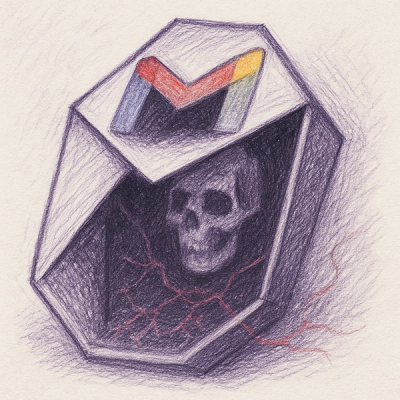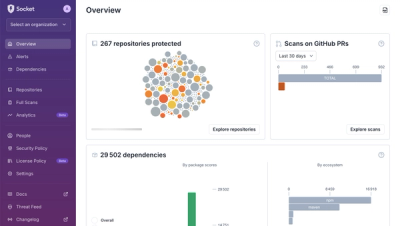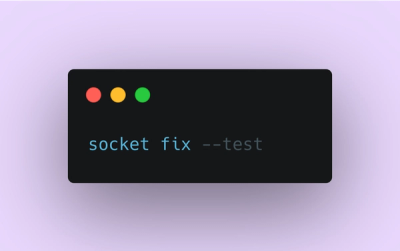
Research
Using Trusted Protocols Against You: Gmail as a C2 Mechanism
Socket uncovers malicious packages on PyPI using Gmail's SMTP protocol for command and control (C2) to exfiltrate data and execute commands.
aframe-react
Advanced tools





npm install --save aframe aframe-react react react-dom
yarn add aframe aframe-react react react-dom
import 'aframe';
import 'aframe-particle-system-component';
import {Entity, Scene} from 'aframe-react';
import React from 'react';
import ReactDOM from 'react-dom';
class VRScene extends React.Component {
render () {
return (
<Scene>
<Entity geometry={{primitive: 'box'}} material={{color: 'red'}} position={{x: 0, y: 0, z: -5}}/>
<Entity particle-system={{preset: 'snow'}}/>
<Entity light={{type: 'point'}}/>
<Entity gltf-model={{src: 'virtualcity.gltf'}}/>
<Entity text={{value: 'Hello, WebVR!'}}/>
</Scene>
);
}
}
ReactDOM.render(<VRScene/>, document.querySelector('#sceneContainer'));
See aframe-react-boilerplate for a basic example.

A-Frame is a web framework for building virtual reality experiences. Since A-Frame is built on top of the DOM, web libraries such as React, Vue.js, Angular, Ember.js, d3.js are able to sit cleanly on top of A-Frame.
A-Frame is an entity-component-system (ECS) framework exposed through
HTML. ECS is a pattern used in game development that
favors composability over inheritance, which is more naturally suited to 3D
scenes where objects are built of complex appearance, behavior, and
functionality. In A-Frame, HTML attributes map to components which are
composable modules that are plugged into <a-entity>s to attach appearance,
behavior, and functionality.
Released on the same day as A-Frame, aframe-react is a very thin layer on top
of A-Frame to bridge with React. aframe-react passes React props to directly
A-Frame using refs and .setAttribute(), bypassing the DOM. This works since
A-Frame's .setAttribute()s are able to take non-string data such as objects,
arrays, or elements and synchronously modify underlying 3D scene graph.
// aframe-react's <Entity/> React Component
<Entity geometry={{primitive: 'box', width: 5}} position="0 0 -5"/>
// renders
<a-entity>
// and then applies the data directly to the underlying 3D scene graph, bypassing the DOM.
<a-entity>.setAttribute('geometry', {primitive: 'box', width: 5});
<a-entity>.setAttribute('position', '0 0 -5');
aframe-react provides the best of both worlds between A-Frame and React, the
3D and VR-oriented entity-component architecture of A-Frame, and the view and
state management ergonomics of React, without penalties of attempting to use
React for a VR application.
A-Frame and aframe-react gives some viability for React to use in VR
applications. The value proposition of React is limited to the 2D Web:
However, these propositions fall short in 3D and VR applications:
A-Frame and aframe-react gives meaning and purpose to React: A-Frame provides an actual DOM for React to reconcile, diff, and bind to.
React also raises questions around performance; React is a very large library designed for a 60fps 2D Web, is it equipped to handle 90fps VR applications? 90 prop updates per second per object for many objects through React's engine causes concern in the overhead added for each operation.
aframe-react lets A-Frame handle the heavy lifting 3D and VR rendering and behavior. A-Frame is optimized from the ground up for WebVR with a 3D-oriented entity-component architecture. And aframe-react lets React focus on what it's good at: views, state management, and data binding.
A-Frame's entity-component-system (ECS) pattern is tailored for 3D and VR applications. What React did for 2D web applications is what ECS did for 3D applications in terms of providing a useful abstraction. ECS promotes composability over hierarchy. In 3D applications, composability refers to composition of appearance, behavior, and logic rather than having fixed blocks. This lets us do things like define a flying robot that explodes on contact and makes robot sounds by snapping together a pre-existing model component, explode component, event handler component, sound component, and flying component.
Unfortunately, React (and the 2D web for that matter) is heavily hierarchical,
which is not suited for 3D. Whereas 2D web development consisted of structuring
and laying out from an assorted set of fixed 2D elements (e.g., <p>, <a>,
<img>, <form>), 3D development involves objects that are infinite in
complexity and type. ECS provides an easy way of defining those objects by
mixing and matching plug-and-play components.
With aframe-react, we get the best of both worlds. The 3D and VR architecture of A-Frame, and the view and state ergonomics of React. React can be used to bind application and state data to the values of A-Frame components. And we still have access to all the features and performance of A-Frame as well as A-Frame's community component ecosystem.
aframe-react's API is very thin on top of A-Frame, less than 200 lines of
source code. The API consists of just two React Components: <Entity/> and
<Scene/>.
<Entity/> wraps
<a-entity>, the entity
piece of the entity-component-system
pattern. Plug in A-Frame
components
as React props to attach appearance, behavior, or functionality to the
<Entity/>.
<Scene>
<Entity
geometry={{primitive: 'box', width: 5}}
material={{color: red, roughness: 0.5, src: texture.png}}
scale={{x: 2, y: 2, z: 2}}
position={{x: 0, y: 0, z: -5}}/>
</Scene>
Community A-Frame components can be imported and installed through npm:
import 'aframe-particle-system-component';
import 'aframe-mountain-component';
// ...
<Scene>
<Entity mountain/>
<Entity particle-system={{preset: 'snow', particleCount: 5000}}/>
</Scene>
primitiveTo use A-Frame primitives, provide
the primitive prop with the primitive's element name (e.g., a-sphere).
Mappings can be applied the same as in HTML through React props:
<Entity primitive='a-box' color="red" position="0 0 -5"/>
<Entity primitive='a-sphere' color="green" position="-2 0 -3"/>
<Entity primitive='a-cylinder' color="blue" position="2 0 -3"/>
<Entity primitive='a-sky' src="sechelt.jpg"/>
eventsTo register event handlers, use the events prop. events takes a mapping of
event names to event handler(s). Multiple event handlers can be provided for a
single event name by providing an array of functions. Try not to pass in inline
functions to not trigger unnecessary React renders. Pass in binded functions
instead.
For example, using the synthetic click event provided by A-Frame's cursor
component, or a collided event possibly provided by a physics component.
handleClick = () => {
console.log('Clicked!');
}
handleCollide = () => {
console.log('Collided!');
}
render() {
return (
<Scene>
<Entity events={{
click: this.handleClick,
collided: [this.handleCollide]}}/>
</Scene>
);
}
aframe-react does not support React-style onXXX event handlers (e.g.,
onClick). Unlike 2D web pages, VR sites are composed entirely of custom
synthetic event names (which could have hyphens, be all lowercase, be
camelCase, all uppercase, camel case, etc.,). The possible event names are
infinite. The events prop makes it explicit what the event names to handle
are.
_refUse aframe-react's _ref prop to add a callback to the underlying
<a-entity> DOM node:
<Entity _ref={this.entityCallback}/>
<Scene/> extends <Entity/> and renders <a-scene> instead of <a-entity>.
Place all <Entity/>s as a child of the <Scene/> Component. There should
only be one <Scene/> per page:
<Scene>
<Entity/>
</Scene>
Let A-Frame and three.js handle the heavy lifting of 3D rendering and behavior, and delegate React to what it was meant for: views, state management, and data binding.
For example, don't create requestAnimationFrames to continuously throw React
prop updates to A-Frame. Instead, create an A-Frame component with a tick
handler such that everything is done in memory with little overhead. Do however
use React to set up initial state and data binding that might configure that
A-Frame component.
aframe-react works with Preact. Since aframe-react uses React.Component,
we have to tell Webpack to alias that to Preact.Component:
resolve: {
alias: {
react: 'preact'
}
}
FAQs
Build virtual reality experiences with A-Frame and React.
The npm package aframe-react receives a total of 286 weekly downloads. As such, aframe-react popularity was classified as not popular.
We found that aframe-react demonstrated a not healthy version release cadence and project activity because the last version was released a year ago. It has 1 open source maintainer collaborating on the project.
Did you know?

Socket for GitHub automatically highlights issues in each pull request and monitors the health of all your open source dependencies. Discover the contents of your packages and block harmful activity before you install or update your dependencies.

Research
Socket uncovers malicious packages on PyPI using Gmail's SMTP protocol for command and control (C2) to exfiltrate data and execute commands.

Product
We redesigned Socket's first logged-in page to display rich and insightful visualizations about your repositories protected against supply chain threats.

Product
Automatically fix and test dependency updates with socket fix—a new CLI tool that turns CVE alerts into safe, automated upgrades.